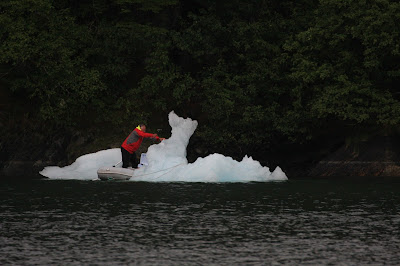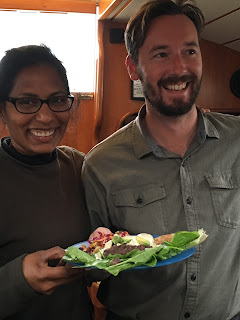We jousted with icebergs today. We left Snug Harbor at 5am to make it to the Tracy Arm bar at an early slack and started seeing icebergs well before Tracy Arm. A lone berg was rolling along out in Stephens Passage with a dozen birds perched on top. There was also a cluster of bergs grounded on the bar, but thankfully none that impeded our progress into Tracy Arm.
The first several miles of the arm were dotted with occasional icebergs and the wind was wandering along with us. The further we proceeded, the stronger the winds got (making me want to put the sails up), and the more closely packed the icebergs became (making me want to leave them furled). At times the bergs were so closely spaced that we were forced to reduce our speed to a crawl to avoid hitting them. They ranged in size from typewriters to city blocks. Some were dark and dirty, some were blue and etherial. Some were snow white and some were clear and nearly transparent. It was the latter class that were the most difficult to spot and forced us to put lookouts on the bow to guide us through the ever more crowded obstacle course. By the time we were twelve miles up the arm with that much left to go, the wind was snorting along behind us at 24 knots. We rounded a corner and the field became a chaos of bergs too dense to penetrate.
With some regret we turned around. Another small motor-cruiser arrived at about the same time we did and turned around when we did, but a steel tour boat plowed right on by.
Turning around, we suddenly found the 24 knots in our faces; the apparent wind went from 18 to 30 knots - a tough slog. Adding insult to injury, the carefully timed flood current that was to carry us all the way up the arm, was now pushing against us.
While we didn’t get to see the glaciers calving, it was a lot of fun navigating through the icebergs, even if it demanded a great deal of attention. And the passage was stunningly beautiful with cascading waterfalls and steep cliff faces all around us. It was a whole other world. Aside from the occasional boater, we had only birds and a group of seal pups to share it with.
After setting the anchor in Tracy Arm Cove for the night, Frederic paddled the dinghy out to a small berg in the anchorage and chiseled some pieces off and into the cooler: fresh water! With that and a little more water in the tanks than we thought, we think we have enough for one more night out before heading into Juneau. Taku Harbor here we come!
































